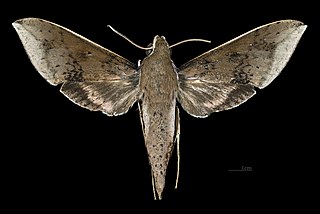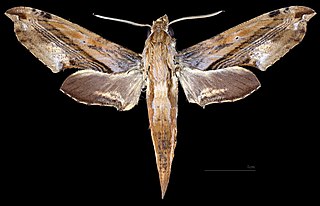
Eupanacra mydon, the common rippled hawkmoth, is a moth of the family Sphingidae.

Macroglossum affictitia, the dark-bordered hummingbird hawkmoth, is a moth of the family Sphingidae. It is known from Sri Lanka and southern India to Myanmar, Thailand and south-western Yunnan, China. It was described by Arthur Gardiner Butler in 1875.

Macroglossum glaucoptera, the dark hummingbird hawkmoth, is a moth of the family Sphingidae. It was described by Arthur Gardiner Butler in 1875. It is known from Sri Lanka, Thailand, southern China, Vietnam, Malaysia (Peninsular), Indonesia and the Philippines (Mindanao). Single specimen recorded from Papua New Guinea.

Clanidopsis is a genus of moths in the family Sphingidae, containing only one species Clanidopsis exusta, the white-streaked hawkmoth. The genus was erected by Walter Rothschild and Karl Jordan in 1903 and the species was first described by Arthur Gardiner Butler in 1875.

Acosmeryx sericeus is a moth of the family Sphingidae. It was described by Francis Walker in 1856.

Rhagastis velata, the veiled mottled hawkmoth, is a moth of the family Sphingidae. It is known from Nepal, north-eastern India, Thailand, central and southern China and Taiwan.

Rhagastis rubetra is a moth of the family Sphingidae. It is known from Indonesia north through Malaysia to Thailand and possibly southern Tibet, China.

Rhagastis olivacea, the olive mottled hawkmoth, is a moth of the family Sphingidae.

Rhagastis gloriosa, the crimson mottled hawkmoth, is a moth of the family Sphingidae.

Rhagastis confusa, the indistinct mottled hawkmoth, is a moth of the family Sphingidae.

Rhagastis castor is a moth of the family Sphingidae first described by Francis Walker in 1856.

Rhagastis acuta is a moth of the family Sphingidae. It is known from south-east Asia, including India, Thailand and Indonesia.

Hayesiana triopus, the nonsuch hawkmoth, is a moth of the family Sphingidae. It is known from Nepal, north-eastern India, southern China and Thailand.

Eurypteryx bhaga, the hook-winged hawkmoth, is a moth of the family Sphingidae first described by Frederic Moore in 1866.

Eupanacra busiris, the green rippled hawkmoth, is a moth of the family Sphingidae.

Eupanacra malayana, the Malayan rippled hawkmoth, is a moth of the family Sphingidae.

Eupanacra sinuata, the sinuous rippled hawkmoth, is a moth of the family Sphingidae. It is known from Nepal, north-eastern India, south-western China, northern Thailand and Vietnam.

Cechetra minor, the lesser green hawkmoth, is a moth of the family Sphingidae.

Ambulyx substrigilis, the dark-based gliding hawkmoth, is a species of moth of the family Sphingidae. It was described by John O. Westwood in 1847.




















